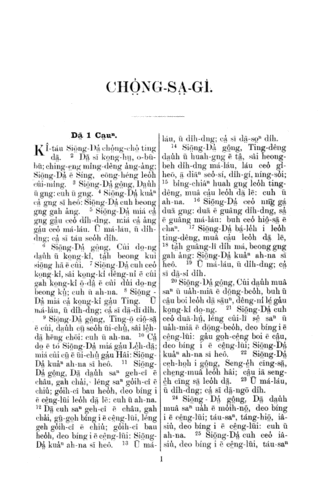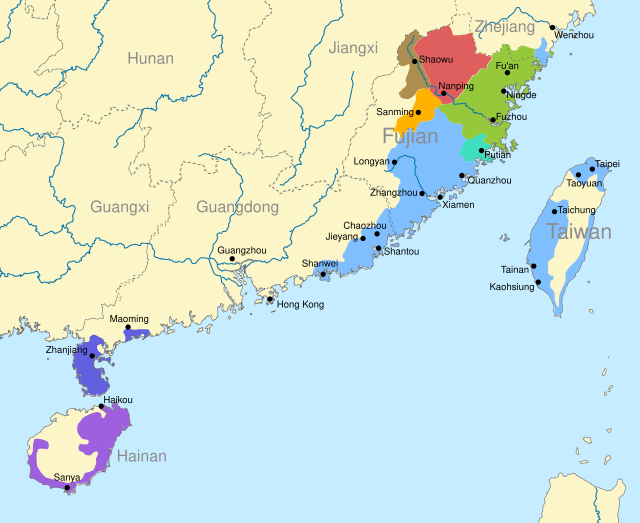Top Qs
Timeline
Chat
Perspective
Pu–Xian Min
Min Chinese language From Wikipedia, the free encyclopedia
Remove ads
Pu–Xian Min (Hinghwa Romanized: Pó-sing-gṳ̂; traditional Chinese: 莆仙話; simplified Chinese: 莆仙话; pinyin: Púxiānhuà), also known as Putian–Xianyou Min, Puxian Min, Pu–Xian Chinese, Xinghua, Henghua, Hinghua or Hinghwa (Hing-hua̍-gṳ̂; traditional Chinese: 興化語; simplified Chinese: 兴化语; pinyin: Xīnghuàyǔ), is a Chinese language that forms a branch of Min Chinese. Pu-Xian is a transitional variety of Coastal Min which shares characteristics with both Eastern Min and Southern Min, although it is closer to the latter.

The native language of Putian people, Pu-Xian is spoken mostly in Fujian province, particularly in Putian city and Xianyou County (after which it is named), parts of Fuzhou, and parts of Quanzhou. It is also widely used as the mother tongue in Wuqiu Township, Kinmen County, Fujian Province, Republic of China (Taiwan). More than 2,000 people in Shacheng, Fuding in northern Fujian also speak Pu-Xian.[5] There are minor differences between the dialects of Putian and Xianyou.
Overseas populations of Pu-Xian speakers exist in Malaysia, Indonesia and Singapore. Speakers of Pu-Xian are also known as Henghua, Hinghua, or Xinghua.
Remove ads
History
Before the year 979 AD, the Pu-Xian region was part of Quanzhou county and hence people there spoke a form of Southern Min.[6][7]
In 979 AD, during the Song dynasty, the region was administratively separated from Quanzhou and the Chinese spoken there developed separately from the rest of Southern Min. Due to its proximity with Fuzhou, it absorbed some elements of Eastern Min, such as morphophonemic alternations in initial consonants, but its basic linguistic characteristics, i.e. grammar and most of its lexicon, are based on Southern Min. It also shares denasalization of historical nasal consonants and vocalic nasalization with Southern Min varieties.[8]
Pu–Xian Min has been shown to be 62% cognate with Quanzhou dialect (Southern Min) and only 39% cognate with the Fuzhou dialect (Eastern Min).[9]
Remove ads
Characteristics
Differences with Southern Min dialects
Pu-Xian differs from most Southern Min varieties in several ways:
- The vowel 'a' is replaced by /ɒ/ (o̤) in most cases, e.g. 腳 ko̤ "leg".
- The vowel 'ư' /ɯ/ is replaced by /y/ ('ṳ'), e.g. 魚 hṳ "fish".
- In Putian 'ng' has changed to /uŋ/ except after zero initial and h- (notation: ng), e.g. 湯 tung "soup".
- The vowel /e/ is often replaced by /ɒ/ o̤, e.g. 馬 bo̤ "horse".
- Where Quanzhou has 'ĩ' and Zhangzhou has 'ẽ', the corresponding Putian vowel is 'ã', e.g. 病 baⁿ "sick", where ⁿ indicates a nasalized vowel.
- The vowel 'io' is replaced by 'iau' (notation: a̤u), e.g. 笑 ciao "laugh". This also holds for nasalized vowels, e.g. 張 da̤uⁿ corresponding to Zhangzhou tioⁿ.
- Nasals 'm' sometimes occur in place of voiced stops 'b', e.g. 夢 mang vs. Quanzhou bang.
- Initial consonant 'ng' replaces 'g' e.g. 五 'ngo' vs. Quanzhou 'go'.
- There is a loss of distinction between voiced and unvoiced stops, e.g. the sounds /b/ and /p/ both correspond to the same phoneme and occur in free variation.
Borrowings from Eastern Min
- Wife 老媽 (Lau Ma)
Remove ads
Phonology
Summarize
Perspective
Pu-Xian has 15 consonants, including the zero onset, the same as most other Min varieties. Pu-Xian is distinctive for having a lateral fricative [ɬ] instead of the [s] in other Min varieties, similar to Taishanese.
Pu-Xian has 53 finals and 6 phonemic tones.
Initials
- β (only appears in connected speech, as a result of consonant mutation of [p])
Finals
Pu–Xian Min has 53 finals (including nasalised finals)
Tone
Register
Assimilation
新婦房 ɬiŋ pu paŋ → ɬiŋ mu βaŋ
青草 tsʰɔŋ tsʰau → tsʰɔŋ nau
Comparison between Putian Min and Quanzhou Min Nan
Remove ads
Sentence-final particles
- ah (啊): used to express exclamation.
- lah (啦): used to stress or for adding emotional effect to words.
- neh (呢): used for questioning.
- nɔ (唔): used to express emotion.
- yɔu (哟): used to denote obviousness or contention.
Romanization
Hing-hua̍ báⁿ-uā-ci̍ (興化平話字) is the Romanization system for Pu–Xian Min. It has 23 letters: a a̤ b c ch d e e̤ g h i k l m n ng o o̤ p s t u ṳ.
The Romanization only needs five tone marks for seven tones:
- 陰平 Ing-báⁿ (unmarked)
- 陰上 Ing-siō̤ng ˆ (â)
- 陰去 Ing-kṳ̍ ˈ (a̍)
- 陰入 Ing-ci̍h (unmarked)
- 陽平 Ió̤ng-báⁿ ́ (á)
- 陽去 Ió̤ng-kṳ̍ – (ā)
- 陽入 Ió̤ng-ci̍h ˈh (a̍h)
Remove ads
Notes
References
External links
Wikiwand - on
Seamless Wikipedia browsing. On steroids.
Remove ads

